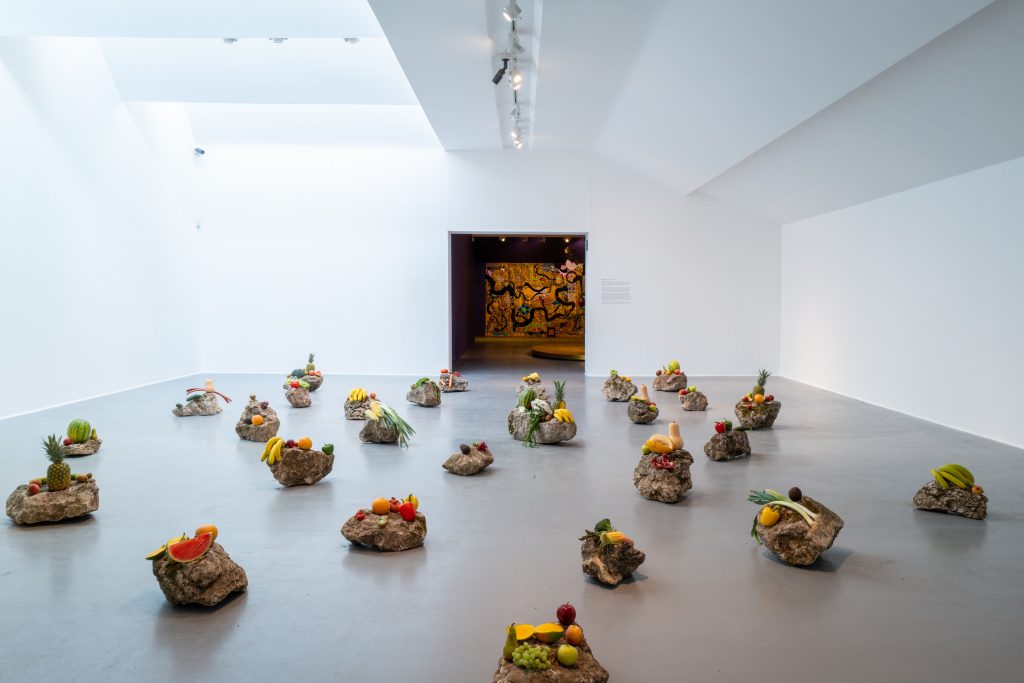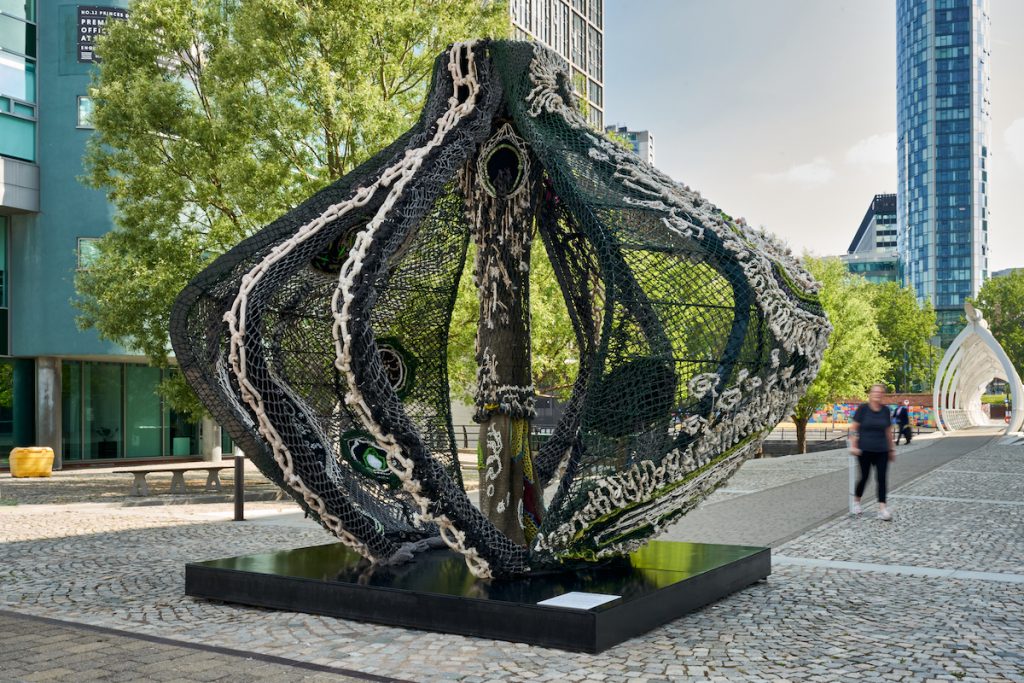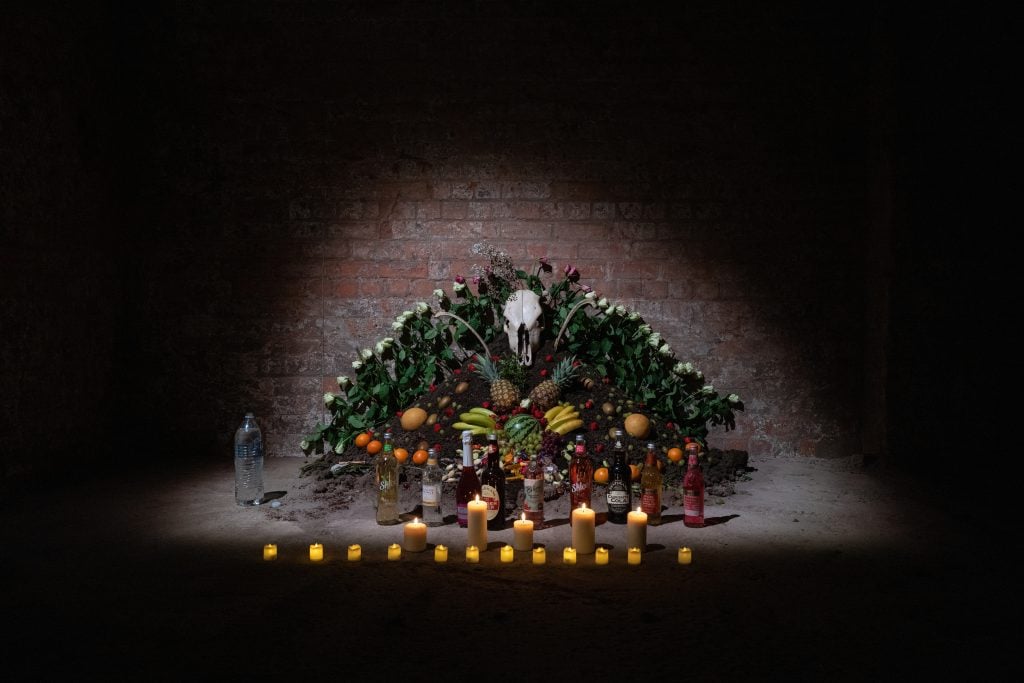Large identical steel structures, reminiscent of the bottom of a ship’s hull, tower over viewers in a dimly lit room at the Tate Liverpool. They are smooth at the bottom, with hollowed centers, while their upper halves are coarse, as if their maker had extracted these shapes straight from water.
The trio of sculptures signify gateways, shelters or shipping routes between Europe, West Africa and the Americas where up to 2.4 million enslaved Africans died. For many people visiting this year’s Liverpool Biennale, on view until September, this weighty work of art by artist Torkwase Dyson will be the first piece they encounter and will set the tone for the rest of the festival of contemporary art.
The 12th edition of the Liverpool Biennale, titled ‘uMoya: The Sacred Return of Lost Thing’, explores the dark relationship between Liverpool, slavery and colonialism. While Britain’s history in the slave trade is far from unknown, many may be unaware that much of Liverpool’s wealth in the 18th century stemmed from its involvement in slavery, surpassing Bristol and London as the capital of Britain’s slave trade in the 1740s.
For ‘uMoya’ (meaning ‘spirit, breath, air, climate and wind’ in isiZulu), South African curator Khanyisile Mbongwa invited 35 artists from six continents whose work, as she described in her opening remarks , encompasses “empowering practices. The curator noted that the biennial is an attempt to return “what has been lost and taken from those who have been silenced or forgotten.”

Torkwase Dyson, Liquidate a location (2021). Liverpool Biennial 2023 at the Tate Liverpool. Courtesy of the Liverpool Biennial. Photograph by Mark McNulty
Part of this return is the meaningful renegotiation of spaces with colonial histories. There’s the Cotton Exchange, which was the epicenter of the world’s cotton trade, and the Tobacco Warehouse, a 14-story building where imported rum and tobacco were once stored.
From its first installation to its last, the biennale does what it set out to do: it reminds Britain and the rest of the world of Liverpool’s colonial past. It does this by showing the work of a very different set of artists. That said, there are rare moments that survey the city as it is today. Melanie Penchot’s film project is one of the few moments where the exhibition deals with contemporary issues in Liverpool: Using professional actors and people from the local recovery community, Penguin’s work STEP (2023) explores mental health and addiction in the city through a series of works, culminating in a final hour-long piece.
Among these artists at the Tate, one of the best-known venues of the exhibition, is the imposing British painter Lubaina Himide. The wall reserved for Himid is one of the biennale’s rare examples of paintings that address subversive notions of the sea. In Between My Heart Is Balanced (1991) reimagines a 19th century painting by James Tissot – instead of a white British soldier and two white women on a boat, we find two black women tearing up maps. In Act One, No Cards (1991)two black women at the opera look at a seascape.

Edgar Calel, Ru k’ox k’ob’el jun ojer etemab’el (The echo of an ancient form of knowledge) (2021). Liverpool Biennial 2023 at the Tate Liverpool. Courtesy of the Liverpool Biennial. Photograph by Mark McNulty
Beyond that, much of the biennale is devoted to video and sculptural pieces that are often ceremonial in nature. As a Guatemalan artist Edgar Calelinstallation, The echo of an ancient form of knowledge (2021), various fruits and vegetables were strategically placed on stones as part of a private ritual that took place during the installation.
The public artwork in Liverpool’s historic Princes Dock, titled Ali sa be sa be (2023) (meaning “a large rock wall” in the Rukai language) by artist Eleng Luluan is inspired by the artist’s upbringing within the indigenous Rukai community of southern Taiwan. The bulbous woven structure depicts the legend of the birth of Rukai’s founder, who is said to have been born from a pottery jar protected by two serpents.
Before it was dispatched and after it arrived at its location in Liverpool, Luluan’s translator Apple says they performed an “incarnation ritual” on the job. If you grabbed the piece of Luluan right after the British side of said ritual, among other things, you’ll find various grains, slightly burnt cigarettes, and foliage in front.

Eleng Luluan, Ngialibalibade to the lost myth, (2023). Installation view at Princes Dock, Biennale of Liverpool 2023. Photograph by Rob Battersby. Courtesy of Liverpool Biennial
Additionally, the sculptural series by British-Nigerian artist Ranti Bam Ifa (2021-23) is soft in its expression but still powerful. The piece made for Our Lady and Saint Nicholas Church Garden – the burial place of Liverpool’s first black resident, a former slave – uses abstract sculptures formed by hugging clay structures as they harden, a process which, according to Bam, began one morning when she stumbled across his carvings “in pleading”.
The name refers to two Yoruba words: if aa pre-colonial divination system, and FA, which means to “draw” or “draw” something. “These works merge to mean bringing the divine closer together,” Bam said. Equally subtle but powerful is that of Belinda Kazeem-Kamiński. Breathe (Liverpool) (2023) to FACT Liverpool, a multi-screen video work that engages with the idea of black people breathing freely as a form of liberation by featuring residents breathing through red balloons.
On the other hand, in the tobacco warehouse, The Black Circus of the Bantu Republic (2022), a performance by Albert Ibokwe Khoza, slaps you. In it, Khoza exposes the shameful legacy of black human circuses by tying up spectators and dressing people in monkey masks while forcing them to dance.

Albert Ibokwe Khoza, The Black Circus of the Republic of Bantu, 2023. Liverpool Biennial 2023 at Tobacco Warehouse. Courtesy of the Liverpool Biennial. Photograph by Mark McNulty
Khoza’s show is unpredictable, absurd and sometimes dark, its only downside being that most viewers of the exhibit won’t be able to experience the hauntingly beautiful performance live. Instead, they’ll find remnants of the event in installation form, including a shrine with cow bones, photographs on the walls, and tutus hanging from the ceiling. Having fully experienced Khoza’s piece, it’s hard to imagine these leftovers will achieve the same effect, but it’s an inevitable byproduct of such a masterpiece.
At the end of the biennial, two questions remain unanswered. After all that’s happened, where are we now? And, therefore, where do we go from there? It may be intentional. Perhaps these are the ones we need to ponder, now aided by knowledge of the city’s sordid history.
The Liverpool Biennial runs until September 17.
More trending stories:
Follow Artnet News on Facebook:
Want to stay one step ahead of the art world? Subscribe to our newsletter to receive breaking news, revealing interviews and incisive reviews that move the conversation forward.
